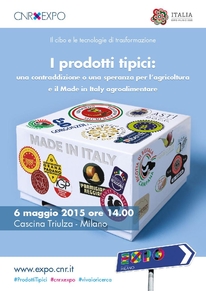Traditional Food Product: hope or contraddiction for a Made in Italy agriculture?

Coordinator: Andrea Scaloni
Institute for animal production system in mediterranean environment (ISPAAM)
Interview to Andrea Scaloni
What kind of event will be organized at Expo?
This event will deal with the typical Made in Italy productions from several points of view, in an effort to narrow a very broad and heterogeneous field dealing with special products that are based on several raw materials and processing, as well as with different costs. In order to ensure a global vision of this scenario, all the stakeholder involved in typical productions will be present at EXPO, from institutions to manufacturers, from chemists to vegetal pathologists and distribution firms delivering these products all over the world as well into the Italian school canteens, training our young people to a correct food consumption. We will also focus on some prestigious initiatives in research, aimed at determining food quality, fighting frauds, and reinforcing economic and environmental sustainability of these productions. We will show the application to meat production of microarray technologies, which is able to identify specific DNA fragments characterizing products from some valuable animal breed, allowing its univocal identification. We will also deal with sophisticated mass spectrometry techniques, identifying proteins and peptides in milk samples, allowing the detection of less estimated bovine milk supposedly illegally added to ovine, buffalo or goat milk, as claimed by some typical productions of dairy industry. These are very important tools indeed, because the Made in Italy has a huge economic impact on Italian trade balance, and it is imperative to protect it, in both national and international markets. At EXPO, we will also show an example of genomic applications in typical productions, introducing the cherry genome: Italy is actually the 4th larger producer of cherries in the world, hosting three DOP and IGP productions. The knowledge deriving from sequencing this genome will provide the community important instruments for the selection of varieties according to specific organoleptic and trading characteristics.
Who is in charge to decide that a Made in Italy product can be qualified as typical?
We actually designate as typical Made in Italy products a variety of very different commercial items, both fresh and processed, showing large differences by nature, value and production procedures. It is rather difficult to regulate and protect this sector on the markets, as we have today about 270 products labelled as DOP and IGP. Many of them have a strong impact over the Italian economic balance, including the prosciutto di Parma (Parma ham), the parmigiano reggiano (parmesan cheese), several sausages, some particular nuts, asparagus, balsamic vinegar of Modena, and so on. There are several European standards establishing the criteria to obtain the DOP and IGP trademark, which regulate the field. During the EXPO event, some representatives of the Food and forest ministry (Ministero delle Politiche Agricole, Alimentari e Forestali) will discuss the regulatory aspects aimed at defending these products, as well the strategies of the different brands to preserve their products on world markets.
Why should our products be protected?
Unfortunately, there are many and frequent frauds against Made in Italy products, and consequently against the final consumer, causing an enormous damage to national enterprises, both from an economical and reputational point of view. We often see the international markets flooded by products different from our DOP and IGP specialties, using raw materials and transforming processes completely different. Among the most risky products are obviously the most valuable: prosciutto di Parma, parmigiano reggiano cheese, Campanian buffalo mozzarella cheese, just to name a few.
Including mozzarella? How can one make a fraud with it?
The mozzarella di bufala campana must be produced using only buffalo milk, 100%. No other milk must be added. Nevertheless, some infringers, often foreigners, use the cheaper bovine milk instead of buffalo milk, or add an old lyophilized or curdled milk to the fresh one, mimicking the genuine buffalo milk. Until the milk is slightly adulterate, it can be hard to notice the fraud. For this reason, it is very important to be able to set up a fast and sensitive method to certify the milk used to produce a foodstuff or the final product itself. For this purpose, a new analytical method will be illustrated, allowing the detection of small quantities of a kind of milk differing from that claimed on the packaging.
What about the meat products?
Some typical meat products, like hams or other sausages, are made by raw materials derived from livestock of a specific national breed, e.g. the Cinta Senese swine, the Casertano or the Nero dei Nebrodi. In case of counterfeit, the meat from different breeds - often raised abroad or of lower organoleptic characteristics - could have been used, contrary to what is stated on the label of the final product. This happens because of the number of the heads of our local breed is limited, its meat is regarded as a valuable material, and the final derived product is considered of better quality and of high economic value. How many are able to appreciate this specificity only from taste? Today, it is possible to identify unequivocally meat products by using microarrays specific for a particular DNA sequence of a defined animal breed.
In addition to those indicated, is there any other technology to ascertain the quality of typical products?
Yes, indeed. For instance, to investigate the nature of a DOP and/or IGP oil of a single variety, some techniques of nuclear magnetic resonance or of chromatography combined with mass spectrometry are available, leading to a detailed oil characterization, at molecular level. There are specific molecular "fingerprints" in biological products, which allow the possibility to ascertain whether extra virgin oil has been mixed with other similar products, possibly less valuable, such as non-extra virgin olive oil, or even seed oil. It is even possible to establish the geographical site of origin of a product, using sophisticated techniques based on isotopic content determination.
Who will be in charge of these controls?
In the last few years, every DOP and IGP product must be subjected to specific inspection plans. This is monitored only by certification authorities, in accordance with EU regulations. These authorities are specialized for the food industry and are authorized from the Italian Ministry of Agriculture, Food and Forestry only if specifically accredited. They can certify that the production techniques and transformation processes comply with the requirements of geographic location and operation mode; that the products conform to the required characteristics (chemical-physical, sensory) and their geographical origin is documented and traceable. Actually, a possible food forgery of DOP and IGP products can affect the raw material utilized, their geographic origin or the location of its processing, and technologies employed for this processing. Several aspects of these issues can be specifically investigated, and many of the technologies mentioned above can assist in the resolution of related problems. Many of them could be centred in specialized facilities, accredited for food analysis; some of them are already in operation in Italy. Hopefully, in the future even CNR will be able to establish some accredited laboratory, conducting analysis to certify the quality of typical products. However, constantly updated regulations must follow the new techniques of investigation, in order to include specific parameters to be respected, and constantly updated according to research in the field. But we should not forget the complexity of the subject, as we are dealing with 270 different products.
Would it be possible for us, in the future, to access some personal tools, to defend ourselves from fraud made on the products we buy?
Most of the above technologies are already available in specialized research facilities, but today they are absolutely inaccessible to single consumers. In the next several years, it is advisable that the costs of these analyses will be lower and lower, allowing any association or consumer group to check the products they buy. And sharing their information will further help to reduce these costs.
Why are some plant pests linked to typical products?
It is necessary to name some of these parasites, although this can sound difficult: in the last few years, an insect of Asian origin, the chestnut gall wasp, is destroying almost the entire production of two specific DOP species, the chestnut of Montella and the marrone of Roccadaspide. This bug not only affects the trees and afflicts some farmers in the province of Avellino, but causes huge damage to several local processing companies, that produce jams, chestnut flour, sweets, etc.; the production of these companies is today at risk, thus compromising the economy of those territories. Italy is Europe's leading manufacturer of chestnuts and is the fourth largest producer in the world. The primacy in the field is not only quantitative but also qualitative, with twelve brand products secured with protection label by Tuscany, Campania, Emilia, Veneto, Piedmont and Lazio. Another example is represented by the phytobacterium Xylella fastidiosa, which is destroying a large part of the Apulian olive trees and consequently the typical local oil production: its presence in those areas has determined a true emergency, like a natural disaster. To protect some typical Made in Italy products, it is therefore essential to improve our knowledge about some plant pests to keep them under control.








